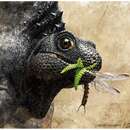en
names in breadcrumbs


Edaphosauridae is a family of mostly large (up to 3 meters or more) Late Carboniferous to Early Permian synapsids. Edaphosaur fossils are so far known only from North America and Europe.
They were the earliest known herbivorous amniotes and, along with the Diadectidae, the earliest known herbivorous tetrapods. The head is small in relation to the bulky body, and there is a tall sail along the back, which may have functioned as a thermoregulatory device.
The interrelationships of Edaphosauridae was investigated in details by David M. Mazierski and Robert R. Reisz (2010). The cladogram below is modified after their phylogenetic analysis.[3]
EdaphosauridaeBelow is a cladogram modified from the analysis of Benson (2012):[4]
AmniotaCaptorhinus spp.
Synapsida Edaphosauridae SphenacodontiaEdaphosauridae is a family of mostly large (up to 3 meters or more) Late Carboniferous to Early Permian synapsids. Edaphosaur fossils are so far known only from North America and Europe.